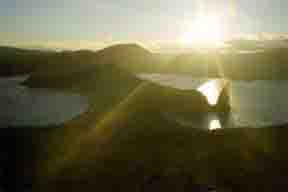Day 4


Watching the sunrise this morning we find ourselves at Bartolomé Island, where after a dry landing, we hike for about 30-minutes along a steep trail and wooden stairs to reach the summit of the volcano. Along the way we observe a variety of colonizing plant species such as Tiquilia and Brachayacerus, or lava cactus. We learn about splatter and parasitic cones, identify aa and ropey lava, and visually trace the course of hollow lava tubes across the island. From the top we have a spectacular panoramic view of the nearby islands, and can clearly observe Pinnacle Rock, an eroded tuft cone in the bay below. This scene is especially beautiful in the early morning light and is the frequent subject of landscape photographs taken in the islands. After descending, we take the panga to a small sandy beach in the cove (wet landing) where there are excellent snorkeling and swimming opportunities. There are 307 species of fish in the islands and schools of colorful tropical fish frequent these waters. We can watch blue parrotfish, white-banded angelfish, blue-eyed damselfish, moorish idols and yellow-bellied triggerfish as well as marine turtles and possibly Galápagos penguins or sea lions, and the calm conditions make the cove a great place to practice snorkeling techniques. A short hike through mangroves takes us across the isthmus to another bay where we might observe white-tipped reef sharks and marine turtle nests.
In
the afternoon those aboard the M/Y Eric will anchor in the channel
between the cigar-shaped Plaza Islands and enjoy a shore excursion
(dry landing) on South Plaza. North Plaza is off limits to visitors.The
principal attractions here are the endemic land iguanas which feed
on the optunia cacti behind the beach. With their lovely yellow scales
and complete lack of fear of humans, these passive vegetarians are
fascinating to observe. Following a loop trail we come to the cliffs
located on the far side of the island. Here swallow-tailed gulls and
other marine bird species nest. The trail winds gradually up to a
high point, passing through fields of colorful
sesuvium which turns bright red at the peak of the dry season. Blue
footed boobies, frigatebirds, pelicans, Audubon's shearwaters and
other birds are always seen from this vantage point, and brown noddys
and red billed tropicbirds are frequently spotted. Returning to the
boat, we pass through a large colony of sea lions starting with the
bachelors who live on the outskirts of the colony and ending with
the females & pups who make up the harems of a couple of large,
sometimes agressive males. Lava lizards, marine iguanas and brown
pelicans are also seen. We have a lecture on the day’s outings
followed by dinner back on board the yacht.
Those aboard the M/Y Flamingo will visit Puerto Egas the best visitor site on James, or Santiago Island (fourth largest island in the archipelago). Along the way we likely sail by Buccaneer Cove, where pirates used to anchor their vessels and whose beautiful cliffs are the nesting sites for hundreds of marine birds. Following a wet landing at Puerto Egas, we walk along the black lava shoreline whose pools, caves and inlets harbor a variety of intertidal wildlife including red, Sally lightfoot crabs which attract hunting herons. We watch dozens of marine iguanas as well as a variety of invertebrates such as starfish, sea anemones, sea urchins, marine snails, barnacles, chitons and limpets. Arriving to the grottos, we may have the chance to enjoy a once-in-a-lifetime opportunity to swim among the lava formations with the Galápagos fur seals. Snorkeling here depends on the tide levels as to enter the grottos requires diving under a lava arch that can be dangerous if the water levels are not just right. Additional wildlife that might be observed at this site include great blue herons, lava herons, Darwin's finches, yellow warblers, and lava lizards. We have dinner on board and a short lecture on tomorrow's activities.